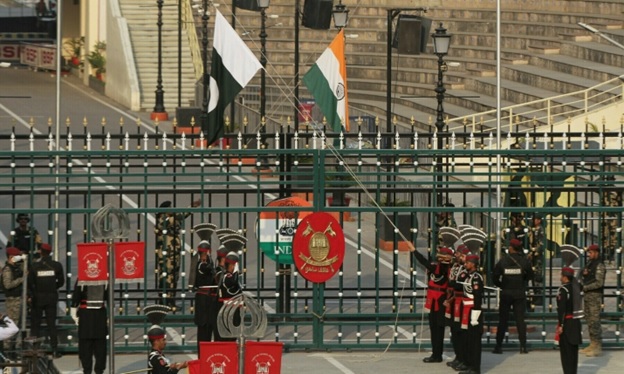
Pakistan Rangers and Indian Border Security Force soldiers lower their national flags at the Pakistan-India joint check post at Wagah border, near Lahore, Pakistan on May 14, 2025. — Reuters/Mohsin Raza
Fragile Truce — A Pause or a Path to Peace?
By Baqir Sajjad Syed
Karachi, Pakistan

It’s been more than a week since Pakistan and India stepped back from the brink, agreeing to a US-brokered ceasefire that gave both countries a much-needed sigh of relief after their most dangerous military standoff in over two decades, but instead of hope settling in, the moment feels fragile, weighed down by tough talk from Indian leaders, Pakistan’s call for deeper dialogue , and the complicated tangle of global politics that makes peace feel more like a pause than a turning point.
On the surface, the May 10 ceasefire has begun to bear fruit. Military forces on both sides have initiated a phased drawdown and returned each other’s soldier that they had taken captive during these tense days. Meanwhile, the military operations chiefs held constructive calls on May 12 and 14, and another is scheduled for May 18. These talks aim to finalise confidence-building measures and a structured mechanism for de-escalation.
Foreign Office spokesman Shafqat Ali Khan noted , “We urge India to adhere faithfully to ceasefire implementation. Directors General of Military Operations of Pakistan and India have maintained periodic contact since 10 May 2025. Both sides have agreed on a structured mechanism for phased de-escalation.”
Even media management — a frequent accelerant of tensions — has been handled with rare discipline by the two sides [after the ceasefire]. DGMOs agreed to shield their discussions from media leaks, a significant step in avoiding narrative-driven escalations, a source privy to the talks disclosed.
Yet, despite this progress, the tone from New Delhi remains intentionally severe. Prime Minister Narendra Modi referred to the ceasefire as a “temporary pause” and Defense Minister Rajnath Singh reinforced that assertion saying, “ Operation Sindoor is not over yet … Pakistan is on probation.”
This hardline rhetoric is aimed squarely at domestic audiences. With elections looming in key states and a national discourse deeply shaped by hyper-nationalism, Indian leadership appears more focused on optics than outcomes.
Shuja Nawaz, distinguished fellow, South Asia Centre, Atlantic Council (Washington DC), observed, “Both sides appear to be playing to the domestic gallery publicly. They need to set an agenda under strict timelines. The agenda should meet both their needs. Endless rhetoric is not needed at this [stage]. [There must be] A clear vision from the top: PM Modi in India and PM Sharif and army chief Asim Munir in Pakistan.”
Islamabad, meanwhile, views the ceasefire as a gateway to a more comprehensive peace process, with Pakistani officials willing to discuss terrorism, but insisting that Kashmir, India’s unilateral suspension of the Indus Waters Treaty , and long-standing grievances must also be on the table.
“Our focus is on stabilizing the situation, consolidate the ceasefire and move towards de-escalation,” FO Khan said during the weekly briefing. For Pakistan, stability means addressing root causes, not simply freezing the conflict.
This asymmetry of intent is a critical fault line. While India wants a narrow, security-centric dialogue, Pakistan demands a political one with regional scope.
US played a central role in brokering the ceasefire, with President Trump and Secretary of State Marco Rubio leading high-level backchannel efforts. Pakistan’s Army Chief General Asim Munir and civilian leadership coordinated closely, while Saudi Arabia provided discreet diplomatic muscle.
Resistance from India
India, however, has bristled at Trump’s repeated claims of facilitating the deal, though its dependence on US trade ties has tempered its reaction. This diplomatic tightrope reveals how global politics continue to shape South Asia’s trajectory.
One of the biggest hurdles now is establishing a venue and mediator for follow-up talks. Rubio’s assertion that there is an agreement on holding talks at a neutral setting is facing resistance from India, which publicly rejects third-party involvement.
There is no shortage of risk — and opportunity. The May 10 ceasefire stopped the immediate bleeding . But unless both sides move beyond performative rhetoric, align on a realistic dialogue framework, and manage domestic constraints, they risk slipping back into familiar patterns of confrontation. - Dawn

